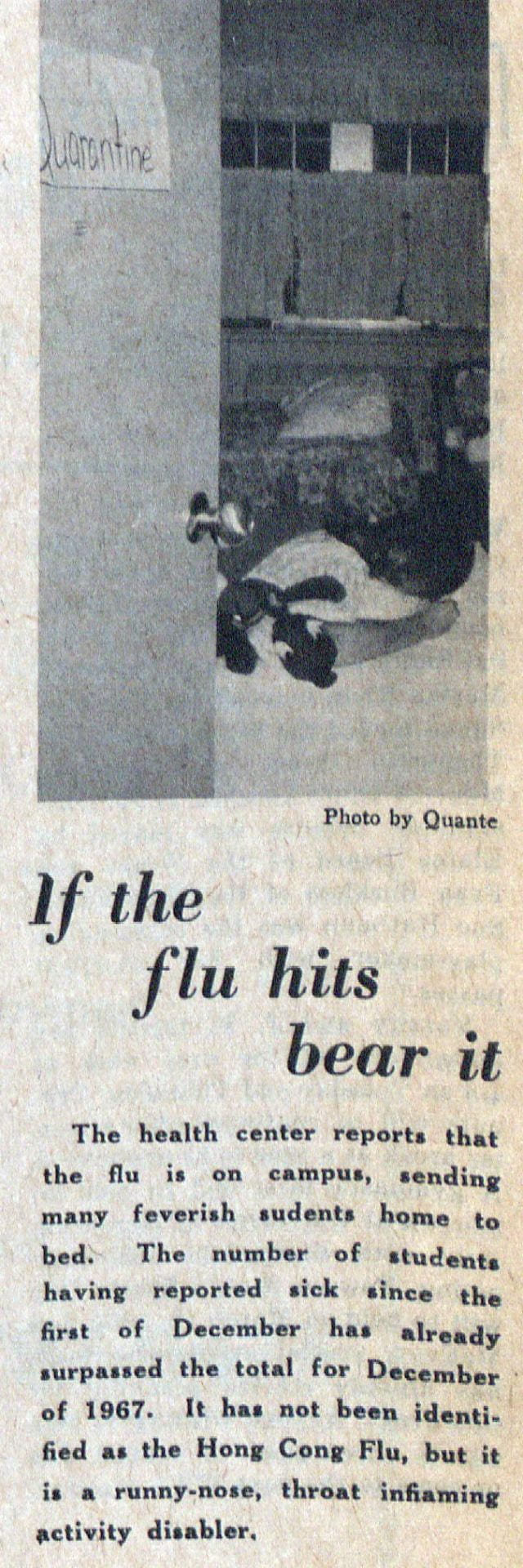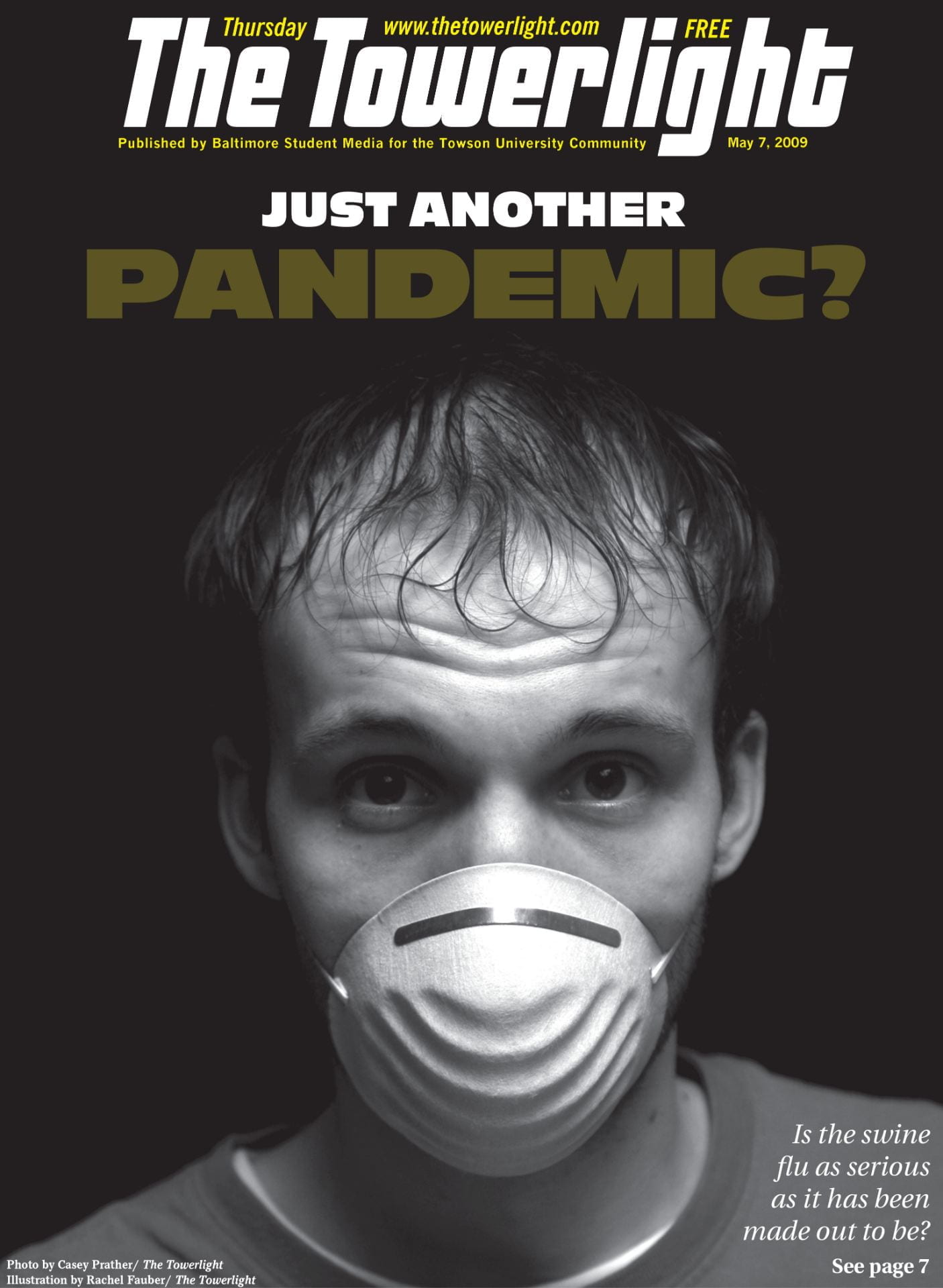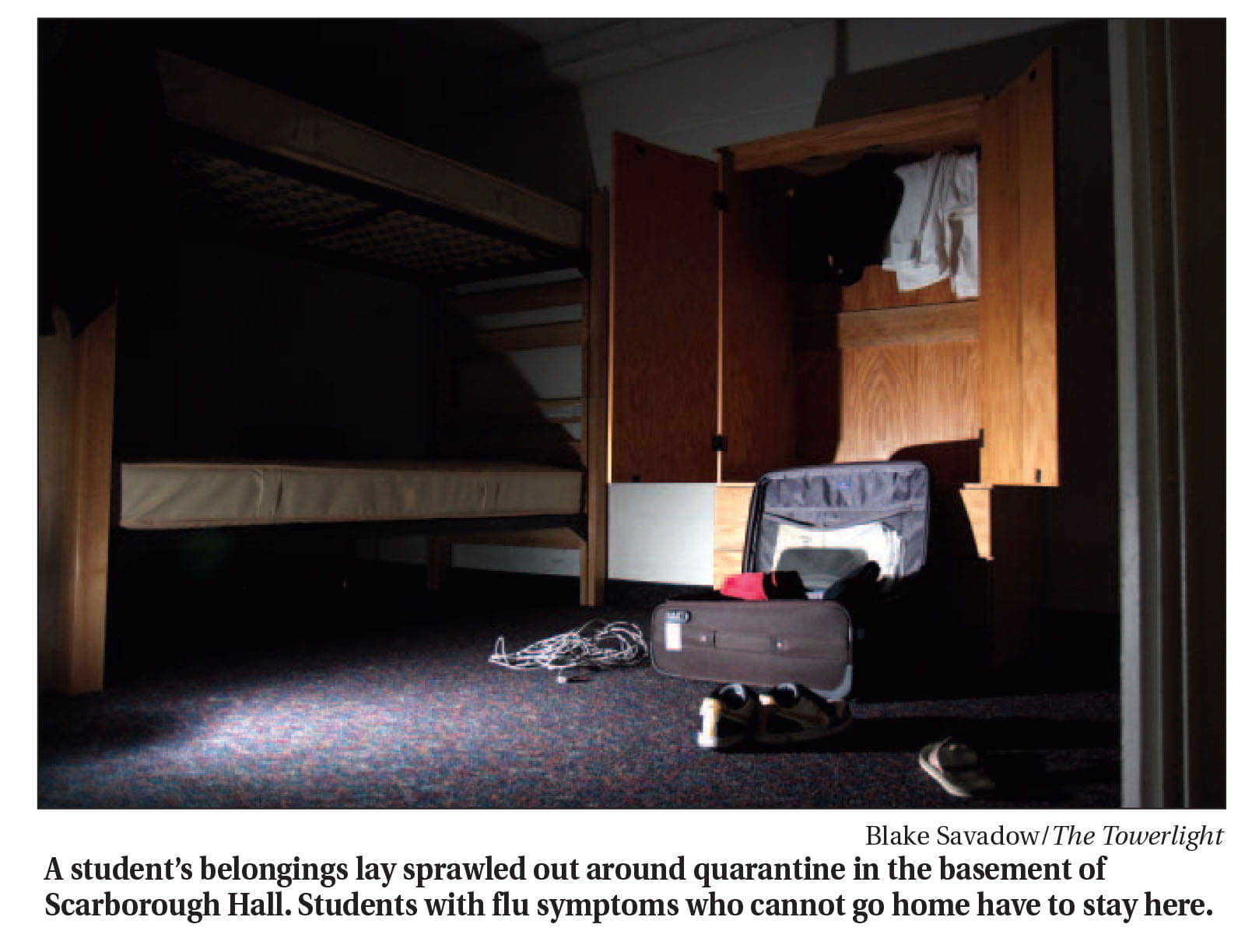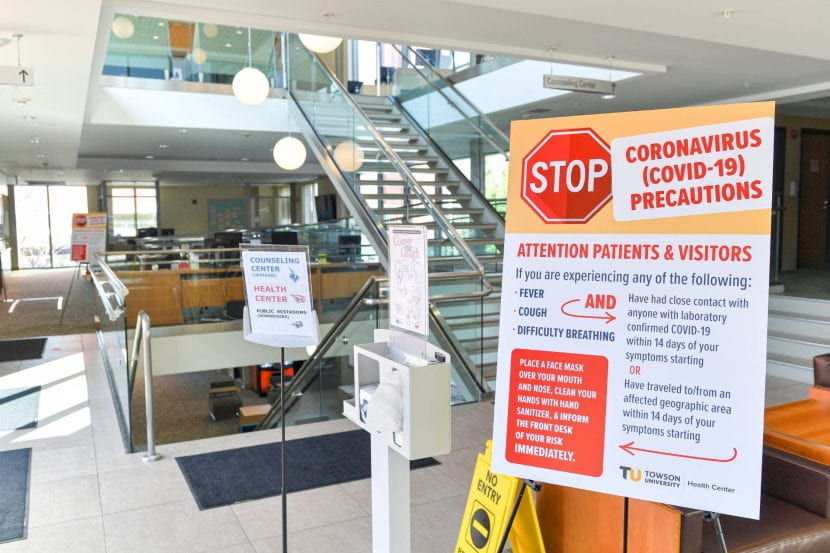While COVID-19 is certainly one of the most extreme health crises that have affected Towson University, it is by no means the first.
In its almost 155-year history, Towson University has witnessed a number of pandemics¹.
When we look back at past pandemics that affected Maryland and the school that would become Towson University, there are many things that seem eerily familiar. As news reports track the spread of victims, officials try to temper people’s fears by suggesting that the illnesses are nothing they are unfamiliar with, like seasonal flu. But as it becomes clear that more and more cases are surfacing, the same measures are put into place: washing hands, extreme social distancing, etc. The school, following health official guidelines, then puts protocols into place, but often that has seemed like an overreaction — which is perhaps why we have been so unaffected by past pandemics.
We are now learning how lucky we have been.
1918-1919 H1N1 Pandemic:
When the first cases of the so-called “Spanish Flu” began showing up in the United States in the summer of 1918, there were concerns about how many people hospitals could treat, and advice about social distancing. These things feel very familiar to us today, even if the approaches were a little less refined.

Through September, while the news coming from Europe and the larger metro areas in the northeast of the US sounded dire, Baltimore Health Commissioner Dr. John D. Blake seemed untroubled. He contended that as there was no suspected cases locally, that people should not worry. He also seemed to feel that calling this flu the “Spanish flu” and suggesting that it was some new contagion was overreacting. On September 20, 1918, the Sun reported:
“In 1890 we had another outbreak, similar to one in France at the same time,” Dr. Blake went on to say. “It was then called la grippe. Now comes along another outbreak, and we are asked to change the name of our old acquaintance and call it Spanish influenza, because it started in Spain.”
By the end of September 1918, volunteers with the Red Cross were busy making masks for the general public to wear, hoping to stem the continued contagion.
Of course, Dr. Blake was tragically wrong. Two weeks after he suggested that this was not a new strain of flu, the flu was declared an epidemic. Slowly the City shut services down including public schools, theaters, stores, churches and the like. Within two weeks, Blake decided that enough time had passed and these services were re-opened. While new flu cases continued to be reported, they were not as severe as they had been in October².
Ultimately, this outbreak would kill over 40 million people across the globe.
At that point, the school that would become Towson University was known as the Maryland State Normal School. It had moved to its Towson campus just three years earlier. Because of World War I, only about 130 students were enrolled, all of them female.
We have no records about the emotional impact the school felt from the 1918-1919 pandemic. At that time there was no student newspaper and while the faculty met to discuss curricular matters, no mention of the flu itself ever shows up in their meeting notes. And there is no suggestion that either students or faculty members were infected. We can only guess that faculty and students were frightened and uncertain about what was happening in their community.
There is, however, some change in the school curriculum, which is most likely influenced by both WWI and the flu outbreak. In both the 1918/1919 and 1919/1920 school years, a two-year “Domestic Science” program was introduced which included classes in “Hygiene”, “Home Nursing and First Aid”, “Laundering”, and “Household Chemistry and Bacteriology”.

While the nursing classes would quickly disappear until the 1970s after the school became a liberal arts school, the hygiene classes would morph into health classes and remain an important component of the school’s program.
1957-1958 H2N2 Pandemic:
In the spring of 1957, a new flu strain showed up in Asia and slowly trekked its way across the globe. While less deadly than the 1918-1919 pandemic, it is estimated that over 1 million people were killed by this strain, most of them in Asia.
The United States was at first spared from high numbers of infected people, but in November a second wave of transmissions began which would prove more devestating to the US. However, a vaccine was rapidly developed which ultimately curtailed the number of casualties in the US.
The school at this point was known as the State Teachers College at Towson. It had an enrollment of just over 1,300 students. Reports in the Towerlight suggest that not many were worried about the pandemic. Only two stories about it show up
during this time, one of which suggested that it was no worse than the seasonal flu — which is something that many have said about the current pandemic.

1968 H3N2 Pandemic
10 years later, another flu began emerging from Asia in the summer of 1968. The world was caught up in massive upheaval, and the war in Vietnam meant that soldiers would ultimately begin spreading this virus, just as they had in 1918. It reached California by September, but did not spread quickly in the US until the winter.
Ultimately, this virus would kill 1,000,000 across the globe.
Like other viruses before it, this one was given a name that tied it to the place where the infection first happened. In this case, it was called the “Hong Kong flu”, as seen in the (misspelled) article above.
Towson State College (TSC) again did not seem overly concerned about this pandemic. An uptick in the number of students going to the Health Center suggests there was more infection. In the winter of 1970, the virus re-surged in Maryland, hitting areas of the state that had not been struck as hard the previous year. A February 1970 Towerlight article interviewed campus physician, Dr. Phelan, about what impact the flu was having on campus. He said that the Health Center was treating about 100 students a day for respiratory symptoms.
The Towerlight article ends with this:
Dr. Phelan says it is not possible to isolate a patient with the flu to prevent the spreading of the infection since others have been exposed by the time the victim shows symptoms himself.
2009-2010 H1n1 Pandemic
On April 15, 2009, a new virus was reported in California. Ten days later, the World Health Organization declared that this new virus was an international public health emergency. This time it was called “H1n1” or “Swine flu” after the virus strain, rather than the community where it first evolved.
Unlike most flu strains, this one had more impact on young people who did not have antibodies to previous H1N1 strains. While it seemed less severe than other pandemics, around 200,000 people across the globe died due to complications of H1N1.
Because of its potential to infect young people, college campuses like Towson University were much more proactive about their response to the virus. By May, there were H1N1 cases in Maryland, and TU had already started putting plans into place about what the response would be should things get worse. Plans on the table included the potential to close the university should infections increase.
Students felt universities were overreacting.

When students returned to campus in the fall, those who displayed flu-like symptoms were put into quarantine in the basements of Prettyman and Scarborough Halls. They had to remain there until their temperatures remained under 100 degrees for 24 hours.

2019-2020 COVID-19
COVID-19 at Towson University: Distance Learning
Spring 2020
In late December 2019, China confirmed a group of pneumonia cases in the city of Wuhan. Several days later, officials in China identified the cause of these pneumonia cases as a new virus – “coronavirus.” The virus was later renamed “COVID-19” by the World Health Organization (WHO) – the acronym stands for “coronavirus disease” and the “-19” refers to 2019, when the virus emerged in China. When the virus first emerged, many thought that it was unlikely to pose a problem for those outside of China. However, the world was quickly proven wrong. On January 20th, the first confirmed case of COVID-19 in the United States was recorded in Washington State. On February 29th, the U.S. recorded its first COVID-19 related death, also in Washington State. At this point, the country had only 24 cases of the virus. On March 26th, just under a month since the first COVID-19 death in the United States, the country led the world in coronavirus cases. At the time of writing this post, the United States has 496,636 cases and there are over 1.6 million cases around the world (via https://www.nytimes.com/interactive/2020/world/coronavirus-maps.html). It is clear from these numbers that life in the United States and around the world has been dramatically impacted by COVID-19 – perhaps far more than most could have expected when the virus first emerged.
As the COVID-19 virus quickly escalated to a global health emergency and then to a pandemic, officials repeated the same phrase: social distancing. Social distancing is a strategy for disease prevention that, according to the CDC, means “keeping space between yourself and other people outside of your home” (https://www.cdc.gov/coronavirus/2019-ncov/prevent-getting-sick/social-distancing.html). So, the question was raised: how would schools maintain operations if students and faculty needed to social distance in order to contain the spread of the virus?
In Maryland, TU first communicated to students regarding COVID-19 on January 27th. On this date, the TU Health Center sent out a campus-wide email saying that they were “actively monitoring the outbreak” of COVID-19, but also reassured the community that there were no confirmed cases in the State of Maryland or at TU. Over the next few weeks as the global situation escalated, TU recalled students and faculty who were abroad due to study abroad programs or other university-related travel. By early March, there were several confirmed cases in Maryland. Over the week of March 9th, TU answered the question of how to maintain operations while needing to social distance in order to curb the spread of a virus that was now dangerously close to our densely populated campus. Their answer, one that is now being practiced by institutions of higher education across the country, was distance learning.
On Tuesday, March 10th, the last week of classes before spring break, TU emailed students to announce that beginning the following day, classes would be cancelled on all campuses. Students were asked to “take all essential belongings, medications, and materials” with them when leaving campus. The email explained that TU was “preparing for the possible necessity” of distance learning after spring break. Within 48 hours, TU announced that it was going to transition classes to distance learning following spring break on Monday, March 23rd. The email stated that face-to-face classes on campus would resume on April 6th. So, students left campus early for spring break, taking their essential belongings with them. Over the course of the spring break, the COVID-19 situation escalated both at home and abroad, with both confirmed cases and deaths rising. Before spring break was over, on March 19th, the University System of Maryland announced that all member universities, including TU, would be transitioning to distance learning for the remainder of the spring 2020 term.
Distance learning at TU began on Monday, March 23rd. At the time of writing this post, students have been learning in an online format for three weeks. Notably, students have been given the ability to select the “pass grading option” due to the abrupt transition to this new type of learning. Distance learning is just how it sounds – in any given class, students are miles and miles apart, yet they are all learning the same content via Blackboard or Zoom or other form of technology. Of course, distance learning is not the same as your typical online course. Distance learning is taking place in the midst of a global pandemic – not only can students not physically interact with their peers and professors, but in many cases, they cannot leave their homes. Students are not only worrying about classwork, but also worrying about the health and safety of friends and family members. Many students undoubtedly have concerns regarding access to technology in an academic space where learning offline isn’t an option.
During past pandemics, institutions like TU have responded in drastic and meaningful ways, showing their dedication to keep students and staff safe and healthy. TU’s response to the COVID-19 pandemic has been no different in the sense that the safety and health of the TU community was and continues to be prioritized. However, distance learning has never been attempted at this scope or under these circumstances in the history of TU or the history of many other universities. TU students are truly making history every time they log into a virtual class or submit a paper to their professor from hundreds of miles away. With roughly four weeks left of classes until finals begin, it will be interesting to observe the impact of distance learning on our students, faculty, and campus community as a whole.
To see a timeline of events as they have happened, please see our TU’s COVID-19 Response post.
Special thanks goes to Cook Library’s A-LIST student, Peyton Cleary, co-author of this blog post, and all-around amazing co-worker, even in our new virtual work world.
- This paper discusses the history of 20th century pandemics.
- This blog post goes into more detail about the impact of the 1918-1919 flu on Baltimore.
Sources
Towson Campus Communication Updates
https://www.towson.edu/news/2020/coronavirus-message.html
New York Times
https://www.nytimes.com/article/coronavirus-timeline.html,
Wikipedia
https://en.wikipedia.org/wiki/Timeline_of_the_2020_coronavirus_pandemic_in_the_United_States,
CNN
https://www.cnn.com/2020/02/06/health/wuhan-coronavirus-timeline-fast-facts/index.html
WBAL
https://www.wbaltv.com/article/timeline-coronavirus-in-maryland/31394971
